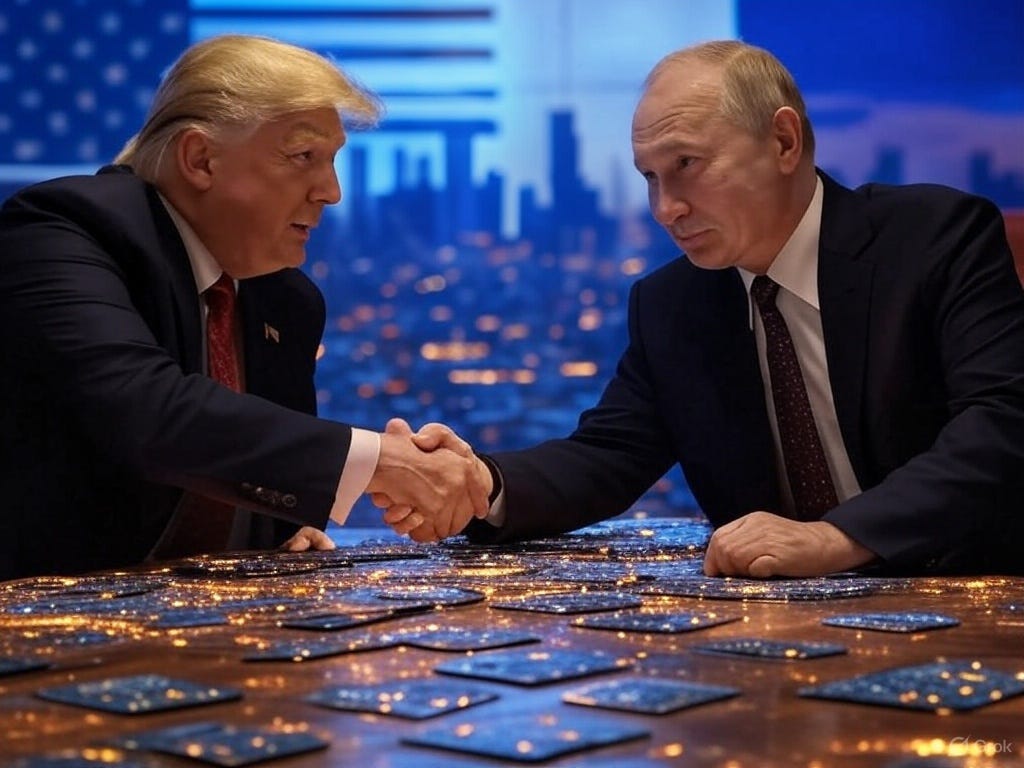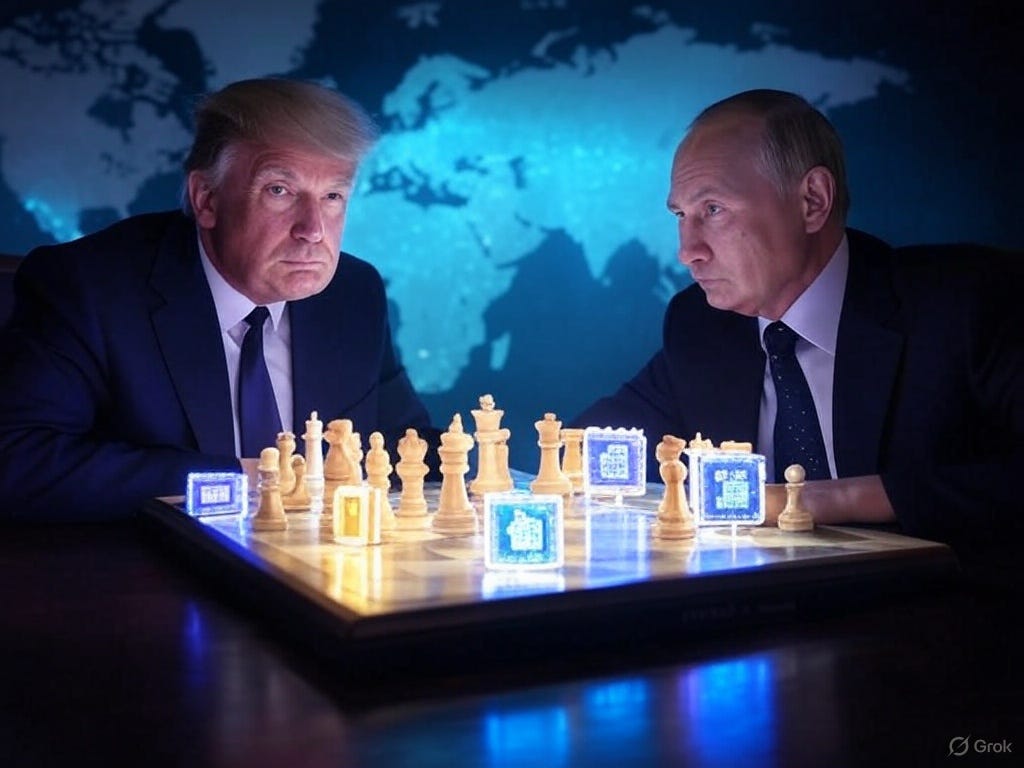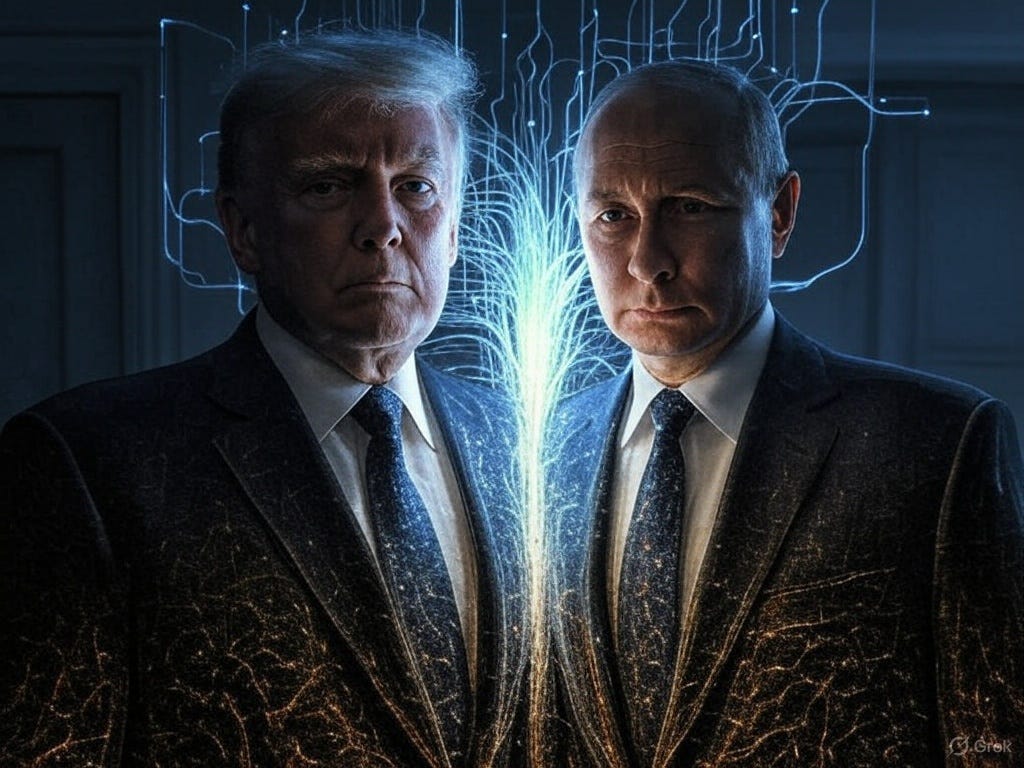Trump's Bargaining Chip: How AI GPUs Could Lead to Peace with Putin
Could AI GPUs be Trump’s key to peace with Putin? This theory explores how tech might stabilize Ukraine, end conflict, and shift global alliances.
In the ever-evolving chess game of global power, certain commodities have historically defined the board—oil fueled empires, gold built wealth, and uranium tipped the scales of war. Today, a new contender has emerged: AI chips, specifically Graphics Processing Units (GPUs), which are driving the artificial intelligence revolution. This blog post explores a bold prediction: that AI GPUs could become the ultimate bargaining chip in a potential U.S.-Russia deal, brokered by a future Trump administration, to secure peace, rare earth minerals, and American manufacturing jobs. More broadly, it underscores a critical truth—nations worldwide are waking up to an AI arms race, and GPUs are the essential component to stay in the game.
This is a speculative theory, not a confirmed policy, but it reflects the growing realization among world powers that AI chips are no longer just tech tools—they’re strategic assets reshaping global trade and geopolitics.
The AI Arms Race: GPUs as the Key to Power
Artificial intelligence is transforming everything—military drones, cybersecurity, economic automation, and beyond. At its core are GPUs, the specialized microchips that power the immense computational demands of AI development. Countries that control access to these chips hold the keys to technological supremacy, while those without them risk falling behind in a race that’s heating up fast.
The parallels to history are striking. Just as oil powered the industrial age and uranium defined the nuclear era, GPUs are now the differentiating commodity in the AI age. World powers like the United States, China, and Russia see AI as a cornerstone of national security and economic strength. The U.S. leads with companies like Nvidia producing cutting-edge chips like the H100, but the gap is narrowing as others scramble to catch up. For any nation aiming to compete, GPUs aren’t optional—they’re essential.
Russia’s Dilemma: Talent Without Tools
Russia is a case study in this high-stakes race. The country boasts some of the world’s most talented software engineers—experts in machine learning, cryptography, and coding who could rival Silicon Valley’s best. But talent alone isn’t enough. To turn their skills into AI breakthroughs, Russia needs GPUs—lots of them. Sanctions and export controls have left Moscow with a critical shortage, hobbling its ability to compete in the AI arena.
This gap makes GPUs a glaring vulnerability—and a powerful incentive. Russia doesn’t just want these chips; it needs them to unlock its potential, modernize its economy, and bolster its military capabilities. In a world where AI is the new frontier, GPUs are the one commodity Russia is poor in, making them a prime target in any negotiation.
The U.S. Agenda: Jobs, Minerals, and Independence
While Russia hungers for GPUs, the United States has its own wishlist. Two priorities stand out: revitalizing local manufacturing and securing rare earth minerals. The U.S. wants to bring high-tech jobs back home, a cornerstone of Donald Trump’s “America First” vision. Producing AI chips domestically could create thousands of skilled positions, boost the economy, and maintain America’s technological edge.
Equally critical are rare earth minerals—elements like neodymium and dysprosium that are vital for tech production, from smartphones to missiles. The U.S. relies heavily on China, which controls over 80% of the global supply, a dependency that’s a strategic Achilles’ heel amid rising tensions. Russia, with its vast reserves of these minerals, offers an alternative. A deal with Moscow could free the U.S. from China’s grip, fueling its tech industries and reducing geopolitical risks.
A Trump-Putin Deal: GPUs as the Bargaining Chip
Enter Donald Trump, a dealmaker with a penchant for bold moves. Trump has long expressed a desire for a peace deal between Russia and Ukraine, a goal that could cement his legacy. But recent events—his fallout with Ukrainian President Volodymyr Zelenskyy and talk of the U.S. distancing itself from NATO—suggest a pivot. If Trump sees Zelenskyy as uncooperative and NATO as a burden, Vladimir Putin might become the partner he turns to.
To get Putin to agree to peace—say, a ceasefire or frozen conflict in Ukraine—Trump needs to offer something big. AI GPUs could be that bargaining chip. Picture this: the U.S. agrees to sell Russia a capped number of GPUs—let’s use 100,000 H100 chips per year as a theoretical example. This would give Russia enough computational power to kickstart its AI ambitions without rivaling U.S. dominance (American AI labs and supercomputers use far more). In exchange, Russia could provide rare earth minerals, helping the U.S. shore up its tech supply chain.
The deal could extend further. Russia might keep territories like Crimea and Donbas, with the U.S. assuring Ukraine stays out of NATO—a key Kremlin demand. Ukraine could be placated with aid or security guarantees. For Trump, it’s a trifecta: peace in Ukraine, minerals for U.S. tech, and manufacturing jobs at home. For Putin, it’s GPUs and a geopolitical win.
The cap on chips, like our 100,000 H100s example, would need flexibility. Technology moves fast—newer, more powerful GPUs will emerge, and the limit would need revisiting to keep the deal viable. It might be tied to U.S. production levels or adjusted as the geopolitical landscape shifts, ensuring both sides benefit long-term.
AI Chips: The New Commodity of Global Trade
This theory isn’t just about one deal—it’s a window into a larger shift. AI chips are becoming the oil, gold, and uranium of the 21st century. Countries that produce them, like the U.S., wield immense leverage—rewarding allies, sanctioning foes, and striking deals that redraw alliances. Nations like Russia, desperate for access, will trade whatever they have to get them.
The AI arms race is making this clear to leaders worldwide. GPUs aren’t just hardware; they’re power—military, economic, and political. As AI grows, expect more trade deals, diplomatic gambits, and even conflicts to hinge on these chips. They’re the bargaining chips of a new era, defining who rises and who falls in the global pecking order.
Conclusion: A Prediction for a Chip-Driven Future
This U.S.-Russia deal is a prediction, not a fact—pure speculation based on current trends. But it highlights a reality we can’t ignore: AI chips are now instruments of statecraft. In the AI arms race, GPUs are the essential ingredient, and nations are racing to secure them. For Russia, they’re the missing piece to unleash its engineers’ potential. For the U.S., they’re leverage to rebuild manufacturing and break China’s mineral monopoly.
If Trump—or any leader—pursues this path, AI GPUs could broker peace, fuel economies, and shift global power dynamics. It’s a gamble, but in geopolitics, the biggest risks often yield the biggest rewards. One thing is certain: as the world wakes up to the AI revolution, these tiny chips will play a massive role in the trade deals shaping our future.





